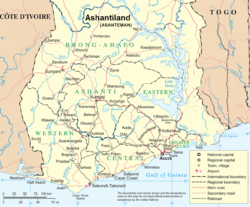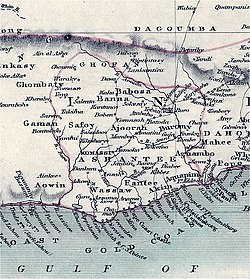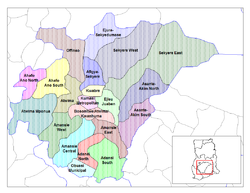Top Qs
Timeline
Chat
Perspective
List of rulers of Asante
From Wikipedia, the free encyclopedia
Remove ads
The Asantehene is the title for the monarch of the historical Ashanti Empire as well as the ceremonial ruler of the Ashanti people today. The Ashanti royal house traces its line to the Oyoko (an Abusua, or "clan") Abohyen Dynasty of Nana Twum and the Oyoko Dynasty of Osei Tutu Opemsoo, who formed the Empire of Ashanti in 1701 and was crowned Asantehene (King of all Asante).[1] Osei Tutu held the throne until his death in battle in 1717, and was the sixth king in Ashanti royal history.[2]
This article needs additional citations for verification. (May 2025) |
The Asantehene is the ruler of the Ashanti people. The Asantehene is traditionally enthroned on a golden stool known as the Sika 'dwa, and the office is sometimes referred to by this name.[3] The Asantehene is also the titular ruler of Kumasi, which served as the capital of the Ashanti Empire and today, the Ashanti Region. The Ashanti Empire comprised parts of present-day southern Ghana and portions of present-day eastern Côte d'Ivoire between the 17th and 20th centuries.[3][4]
The current Asantehene is Otumfuo Nana Osei Tutu II, born Nana Kwaku Dua, who ascended as the 16th Asante king in April 1999. Osei Tutu II was one of seven descendants who were eligible to the heir presumptive.[5]
Remove ads
Elections and regents
During the period between the death of an Asantehene and the election of a successor, the Mamponghene, the Asantehene's deputy, acts as a regent.[1] This policy was only changed during a time of civil war in the late 19th century, when the Kwasafomanhyiamu or governing council itself ruled as regent.[1] The succession is decided by a series of councils of Asante nobles and other royal family members.[1]
Remove ads
The colonial era and Asante independence
Map of Ashantiland (1st left) and the Kingdom of Ashanti (2nd left) and Ashanti Region (2nd right) with its administrative districts (1st right)
The Ashanti Confederacy was made a British protectorate in 1902, and the office of Asantehene was discontinued. In 1926, the British permitted the repatriation of Prempeh I – whom they had exiled to the Seychelles in 1896[6][7] – and allowed him to adopt the title Kumasehene, but not Asantehene. However, in 1935, the British finally granted the Ashanti moderated self-rule as the Kingdom of Ashanti, and the title of Asantehene was revived.[8]
Remove ads
List of rulers
Summarize
Perspective
All rulers in the lists below were members of the Oyoko Abohyen Dynasty.
Kwaamanhene of the Kwaaman State
Kumasehene of the Kumaseman State
Asantehene of the Kingdom of Ashanti (Ashanti Empire)
All regents were members of the Oyoko Dynasty who were and still are the holders of the title Mamponghene.
Upon the death of the Asantehene, it is the task of the Mamponghene to act as the regent, or Awisiahene.[9]
Remove ads
See also
References
Further reading
External links
Wikiwand - on
Seamless Wikipedia browsing. On steroids.
Remove ads







